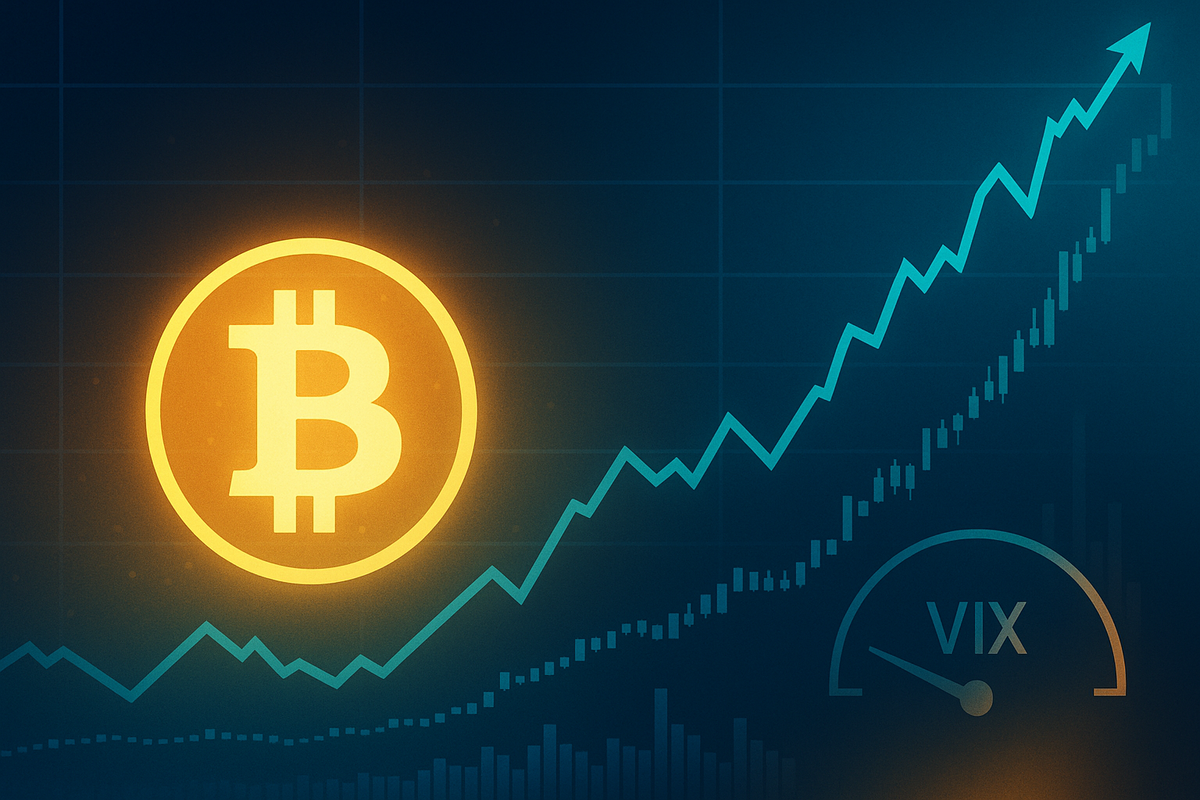
Bitcoin (BTC) is once again making headlines, trading tantalizingly close to its all-time high, a testament to its enduring appeal and growing mainstream acceptance. Simultaneously, the CBOE Volatility Index (VIX), often dubbed Wall Street's "fear gauge," has dipped to remarkably low levels. These dual movements paint a compelling picture of current market sentiment, suggesting a "risk-on" environment where investor confidence is high, and the appetite for higher-risk assets, including cryptocurrencies, is robust.
This confluence of events signals a significant shift in the financial landscape. Bitcoin's resilience and upward trajectory, even after reaching unprecedented peaks, underscore a maturing cryptocurrency market increasingly influenced by institutional adoption and regulatory clarity. The subdued VIX, on the other hand, reflects a broader market complacency, where investors perceive lower immediate risks in traditional equities. Understanding these intertwined dynamics is crucial for investors and market observers alike, as they offer insights into prevailing confidence levels and potential future trends across both digital and conventional asset classes.
Bitcoin's Ascent and the Market's Calm: A Detailed Look
Bitcoin's journey to its current near all-time high status has been nothing short of remarkable. As of August 11, 2025, Bitcoin is hovering around the $119,000 to $122,000 mark, just shy of its record peak of over $122,000 achieved on July 14, 2025. This impressive performance follows a significant year-to-date increase of 27.47%, demonstrating sustained bullish momentum. The primary catalyst for this surge has been the increasing institutional embrace of Bitcoin, particularly following the U.S. Securities and Securities and Exchange Commission (SEC) approval of spot Bitcoin Exchange-Traded Funds (ETFs) in January 2024. This landmark decision opened the floodgates for traditional investors to gain exposure to Bitcoin through regulated financial products, significantly boosting liquidity and legitimacy.
The timeline leading to this moment highlights several key milestones. After the initial ETF approvals, Bitcoin hit a new all-time high of $73,737.94 on March 14, 2024, fueled by record inflows into these new investment vehicles. By December 2024, Bitcoin had surpassed the $100,000 mark, partly buoyed by regulatory optimism under the incoming Trump administration, which later saw President Donald Trump sign an executive order in March 2025 to establish a Strategic Bitcoin Reserve. These developments have solidified Bitcoin's position as a legitimate asset class, attracting not only institutional investors but also corporate treasuries, with companies like MicroStrategy (NASDAQ: MSTR), Tesla (NASDAQ: TSLA), and Marathon Digital Holdings (NASDAQ: MARA) increasingly holding substantial Bitcoin reserves.
In parallel, the CBOE Volatility Index (VIX) has been signaling a period of unusual calm. On August 11, 2025, the VIX was down 8.6% to 15.15, a level that typically indicates stable markets and low expected volatility. Throughout August 2025, VIX readings have consistently remained below 20, and often below 15, suggesting a high degree of investor optimism and a perceived absence of immediate market threats. This contrasts sharply with periods of heightened anxiety, such as March 2020, when the VIX soared to a record high of 82.69 during the onset of the COVID-19 pandemic, or even August 2024, when it spiked above 65.
The simultaneous movements of Bitcoin's ascent and the VIX's dip suggest a prevailing "risk-on" sentiment across financial markets. Key players in the Bitcoin market include major asset management firms like BlackRock (NYSE: BLK) and Fidelity (NYSE: FNF), through their ETF offerings, as well as cryptocurrency exchanges such as Coinbase (NASDAQ: COIN) and Binance. In the broader market, institutional investors and algorithmic trading firms significantly influence VIX levels, while central banks and governments, through their monetary and trade policies, also play a crucial role in shaping overall market volatility. The current environment reflects a collective belief among these players that the path of least resistance for assets is upward, encouraging investment in higher-risk, higher-reward opportunities.
Winners and Losers in a "Risk-On" Environment
The current market dynamics, characterized by Bitcoin's surge and a subdued VIX, create clear winners and potential losers across various sectors. Unsurprisingly, companies deeply entrenched in the cryptocurrency ecosystem are among the primary beneficiaries. Cryptocurrency exchanges like Coinbase (NASDAQ: COIN) stand to gain significantly from increased trading volumes as Bitcoin's price approaches its all-time high, leading to higher transaction fees and revenue. Similarly, Bitcoin miners such as Marathon Digital Holdings (NASDAQ: MARA) and Riot Platforms (NASDAQ: RIOT) benefit directly from the rising value of Bitcoin, as their mined rewards become more valuable. Their profitability is directly tied to Bitcoin's price, and a sustained rally enhances their balance sheets and operational margins.
Beyond direct crypto players, companies that have strategically integrated Bitcoin into their corporate treasuries are also seeing substantial gains. MicroStrategy (NASDAQ: MSTR), a software company that has famously adopted a Bitcoin-first treasury strategy, is a prime example. As the value of their extensive Bitcoin holdings appreciates, so too does their overall market capitalization, often leading to a significant boost in their stock price. Other companies like Tesla (NASDAQ: TSLA), which holds Bitcoin on its balance sheet, also experience a positive impact, albeit to a lesser extent given Bitcoin's smaller proportion of their overall assets. These companies benefit from the perceived strength and growth of the digital asset space, attracting investors looking for indirect exposure to Bitcoin's performance.
On the flip side, a prolonged period of low volatility, as indicated by the VIX, can present challenges for certain market participants. Volatility traders and hedge funds that specialize in profiting from market swings may find their strategies less effective in a calm market. While a low VIX generally signals investor confidence, it can also lead to complacency, potentially setting the stage for sharper corrections if unexpected events occur. Furthermore, traditional safe-haven assets, such as certain government bonds or gold, might see reduced demand as investors flock to riskier, higher-yielding assets. While not necessarily "losers," their relative performance may lag behind growth-oriented stocks and cryptocurrencies in such an environment.
Moreover, companies with high debt loads or those operating in highly cyclical industries might face increased scrutiny if the "risk-on" sentiment suddenly reverses. While the current environment is favorable, an unexpected spike in volatility could expose underlying vulnerabilities. Investors might become less forgiving of companies with weaker fundamentals if the market's appetite for risk diminishes. Therefore, while the immediate beneficiaries are clear, the long-term implications of sustained low volatility and a surging Bitcoin market warrant careful consideration for all market participants.
Industry Impact and Broader Implications
The current market scenario, marked by Bitcoin's near all-time high and a subdued VIX, carries significant implications for various industries and the broader financial landscape. This event fits squarely into the broader trend of digital asset maturation and increasing integration with traditional finance. The approval of spot Bitcoin ETFs was a watershed moment, effectively bridging the gap between the nascent crypto market and established investment vehicles. This has not only legitimized Bitcoin as an investable asset but also paved the way for further institutional adoption and the potential for other cryptocurrencies to follow suit with similar regulated products. The growing acceptance of Bitcoin by corporate treasuries further underscores this trend, signaling a shift in how companies manage their balance sheets and perceive digital assets.
The ripple effects extend beyond the immediate cryptocurrency and financial sectors. The increased liquidity and accessibility of Bitcoin through ETFs could lead to greater innovation in financial products and services. We might see the development of more sophisticated derivatives, lending platforms, and investment strategies built around digital assets. This could challenge traditional banking models and force established financial institutions to adapt and offer more crypto-centric services to remain competitive. Furthermore, the success of Bitcoin ETFs could encourage other asset managers to explore similar offerings for other major cryptocurrencies, potentially expanding the digital asset market significantly.
From a regulatory standpoint, the sustained growth and institutional interest in Bitcoin will likely intensify the focus on comprehensive regulatory frameworks. While the SEC's approval of Bitcoin ETFs was a step forward, governments worldwide will continue to grapple with issues such as consumer protection, market manipulation, and anti-money laundering (AML) compliance in the digital asset space. The establishment of a Strategic Bitcoin Reserve by the U.S. government, as signed by President Trump in March 2025, also highlights a growing recognition of Bitcoin's strategic importance at a national level, potentially influencing future monetary and economic policies.
Historically, periods of low volatility, as indicated by a low VIX, have often preceded significant market corrections. While the current calm suggests confidence, it also raises questions about potential market complacency. The "risk-on" environment could lead to overvaluation in certain sectors, making them vulnerable to sharp pullbacks if unforeseen economic or geopolitical events disrupt the current equilibrium. Comparing this to past cycles, such as the dot-com bubble or the pre-2008 financial crisis period, where low volatility masked underlying risks, provides a cautionary tale. While the current drivers are different, the principle of market complacency remains a critical factor to monitor.
What Comes Next
Looking ahead, the trajectory of Bitcoin and the VIX will be closely watched indicators of market sentiment and potential future movements. In the short term, Bitcoin's ability to decisively break and sustain above its all-time high will be a critical test. A successful breach could trigger further bullish momentum, attracting more retail and institutional investors who may have been waiting for clear signals of continued upward movement. Conversely, a failure to break through, or a significant pullback from current levels, could lead to a period of consolidation or even a short-term correction, as some investors might take profits.
For the VIX, the key question is how long this period of low volatility will persist. While a low VIX suggests stability, an extended period of complacency could lead to an increased risk of a sharp market correction if an unexpected shock occurs. Investors might become overly comfortable with risk, leading to asset bubbles in certain areas. Therefore, any sudden spike in the VIX would signal a shift in market sentiment, potentially prompting a flight to safety and a re-evaluation of risk exposures across portfolios.
In the long term, the continued institutionalization of Bitcoin and other digital assets is likely to be a dominant theme. We can expect further innovation in financial products, potentially including ETFs for other major cryptocurrencies, and increased integration of blockchain technology into traditional financial infrastructure. This could lead to a more mature and regulated digital asset market, attracting a broader base of investors and potentially challenging the dominance of traditional asset classes. Strategic pivots for companies will involve assessing their exposure to digital assets, either by incorporating them into their balance sheets or by developing services that cater to the growing crypto economy.
Potential scenarios include a sustained bull run for Bitcoin, driven by continued institutional adoption and favorable regulatory environments, leading to new all-time highs and further mainstream acceptance. Another scenario could involve increased regulatory scrutiny and potential headwinds, leading to periods of volatility and price corrections. For the broader market, a continued low VIX could lead to a gradual inflation of asset prices, followed by a potentially sharp correction, or it could simply reflect a genuinely stable economic environment. Market opportunities will emerge for those who can effectively navigate these evolving dynamics, whether through direct investment in digital assets, developing blockchain-based solutions, or offering advisory services in this burgeoning space.
Conclusion
The current financial landscape, characterized by Bitcoin nearing its all-time high and a subdued VIX, presents a compelling narrative of evolving market sentiment and the increasing prominence of digital assets. The key takeaway is the growing confidence in Bitcoin as a legitimate and investable asset class, largely driven by significant institutional adoption and the approval of regulated investment vehicles like spot Bitcoin ETFs. This has not only propelled Bitcoin's price but also signaled a broader "risk-on" environment in the markets, where investors are more willing to embrace higher-risk assets.
Moving forward, the market will be closely watching several critical factors. For Bitcoin, the ability to decisively break and sustain above its all-time high will be a crucial indicator of its continued bullish momentum. For the broader market, the VIX will serve as a barometer of investor complacency; any sudden increase could signal a shift in sentiment and potential market turbulence. Investors should remain vigilant, recognizing that while a low VIX suggests calm, it can also precede periods of heightened volatility.
The lasting impact of these events will likely be the further integration of digital assets into the mainstream financial system. This will necessitate continued regulatory development, technological innovation, and strategic adaptations by both traditional financial institutions and emerging crypto companies. Investors should consider diversifying their portfolios to account for the growing influence of digital assets, while also maintaining a keen awareness of broader market sentiment indicators. The coming months will undoubtedly offer further insights into the long-term implications of this dynamic interplay between cryptocurrency growth and traditional market stability.







